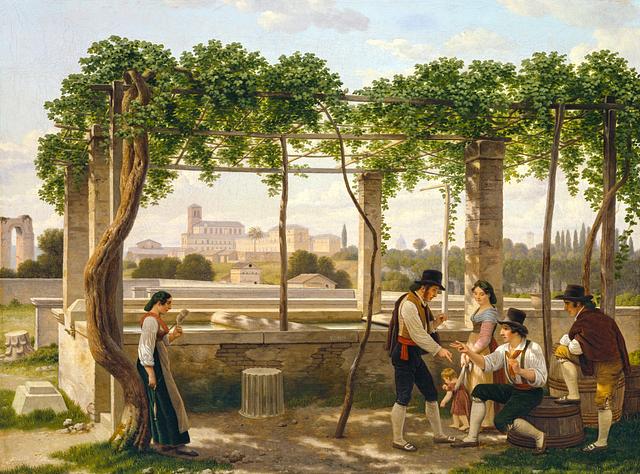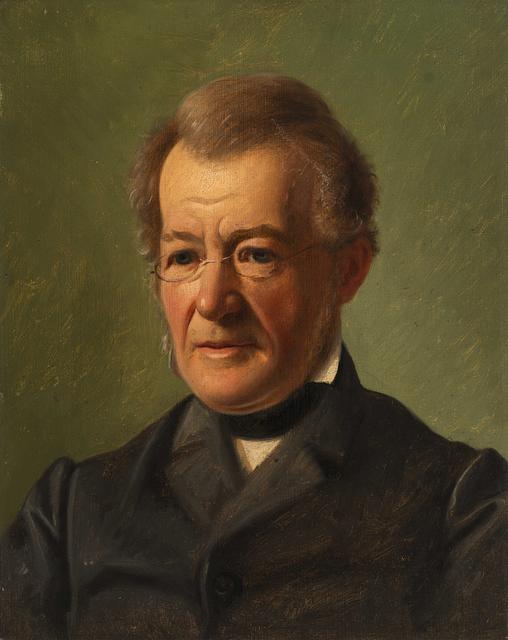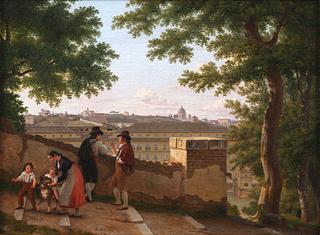C.W. Eckersberg (1783–1853)
Prospect from Monte Aventino, 1824
Oil on canvas
45.5 x 62 cm
Inventory number 17/1969
Eckersberg left Rome in 1816 after having spent three years in the city. Upon arriving in Copenhagen in August 1816, he was soon busy teaching at the Royal Danish Academy of Fine Arts and executing commissioned portraits. He also continued to create Roman prospects. Often, these were near-identical versions of works he had painted in Rome. However, Eckersberg also created new compositions based on the drawings he had done in Rome, and which remained in his possession until his death.1 One such painting is Prospect from Monte Aventino, which, along with its counterpart, Prospect from Villa Casale with SS. Giovanni e Paolo (18/1969), was executed several years after his return to Denmark.
Eckersberg found this subject on Monte Aventino, the southernmost of Rome's seven hills. He chose a point of view where the wall and the solid brick plinth block the view of the port of Porto di Ripa Grande, which lies below the yellow buildings of the Ospizio di. S. Michele, which extend throughout the picture. However, we can just make out the Tiber at the bottom right. Although the architecture of Rome is delegated to the background, the view of the city is nevertheless of great importance. In a very atypical move for Eckersberg, he has here painted one of Rome’s main landmarks, the dome of St. Peter’s Basilica. The reason may be that the painting had to live up to the expectations held by discerning, affluent Danish audiences who preferred pictures that corresponded to their ingrained ideas about Rome.
In the foreground of the painting, a couple of men can be seen conversing by the wall of the stepped road while a woman passes by with her two children, one of whom is riding a dog. The charming, everyday scene has been choreographed into the picture at a later date by the artist as there are no people in the he drawing used as reference.2 This trait makes the painting – and its pendant – stand out noticeably from Eckersberg’s early Roman prospects, partly because he no longer painted in situ, and partly because his focus shifted away from architecture to scenes of everyday life.3 In this regard, it is interesting to point out that depictions of Italian everyday life became a dominant recurring subject among those of Eckersberg’s students who set out for Rome in the decades that followed, including the painters Jørgen Sonne and Wilhelm Marstrand.
Eckersberg found this subject on Monte Aventino, the southernmost of Rome's seven hills. He chose a point of view where the wall and the solid brick plinth block the view of the port of Porto di Ripa Grande, which lies below the yellow buildings of the Ospizio di. S. Michele, which extend throughout the picture. However, we can just make out the Tiber at the bottom right. Although the architecture of Rome is delegated to the background, the view of the city is nevertheless of great importance. In a very atypical move for Eckersberg, he has here painted one of Rome’s main landmarks, the dome of St. Peter’s Basilica. The reason may be that the painting had to live up to the expectations held by discerning, affluent Danish audiences who preferred pictures that corresponded to their ingrained ideas about Rome.
In the foreground of the painting, a couple of men can be seen conversing by the wall of the stepped road while a woman passes by with her two children, one of whom is riding a dog. The charming, everyday scene has been choreographed into the picture at a later date by the artist as there are no people in the he drawing used as reference.2 This trait makes the painting – and its pendant – stand out noticeably from Eckersberg’s early Roman prospects, partly because he no longer painted in situ, and partly because his focus shifted away from architecture to scenes of everyday life.3 In this regard, it is interesting to point out that depictions of Italian everyday life became a dominant recurring subject among those of Eckersberg’s students who set out for Rome in the decades that followed, including the painters Jørgen Sonne and Wilhelm Marstrand.
Published in
Published in
Philip Weilbach: Maleren Eckersbergs Levned og Værker, København 1872, p. 228;
Udstillingen af C.W. Eckersberg’s Malerier i Kunstforeningen, Oktober-November 1895, København 1895, cat. 168;
Emil Hannover: Maleren C.W. Eckersberg: En Studie i dansk Kunsthistorie, Kunstforeningen, København 1898, cat. 318 and p. 188;
Udstilling af dansk Kunst fra Italien i Udstillingsbygningen ved Charlottenborg 1909, København 1909, cat. 70 - (the title given here: Udsigt fra Aventinerbjerget);
V. Winkel & Magnussen (ed.): Kunst i privat eje, vol. 1, København 1944, fig. 14, pp. 143-144;
Vagn Poulsen: ”Guldalderbilleder” in C.L. Davids Samling. Fjerde del, Jubilæumsskrift 1945-1970, København 1970, pp. 23-24, fig, 4, p. 29;
Dansk kunst og kunsthåndværk, Davids Samling, København 1972, p. 10;
Verner Jul Andersen: Dansk kunst og kunsthåndværk, Davids Samling, 2. ed.., København 1983, cat. 414 - (the title given here: Romersk vedute);
Dyveke Helsted, Eva Henschen and Bjarne Jørnæs: C.W. Eckersberg i Rom 1813-16, Thorvaldsens Museum, 1983, cat. 50, p. 115 [with a mistaken acc.no. 16/1969];
Peter Michael Hornung and Kasper Monrad: C.W. Eckersberg – dansk malerkunsts fader, København 2005, pp. 168-169;
C.W. Eckersbergs dagbøger, udgivet og kommenteret af Villads Villadsen, København 2009. Vol. 1, 1810-1836, p. 190, note 7;
Udstillingen af C.W. Eckersberg’s Malerier i Kunstforeningen, Oktober-November 1895, København 1895, cat. 168;
Emil Hannover: Maleren C.W. Eckersberg: En Studie i dansk Kunsthistorie, Kunstforeningen, København 1898, cat. 318 and p. 188;
Udstilling af dansk Kunst fra Italien i Udstillingsbygningen ved Charlottenborg 1909, København 1909, cat. 70 - (the title given here: Udsigt fra Aventinerbjerget);
V. Winkel & Magnussen (ed.): Kunst i privat eje, vol. 1, København 1944, fig. 14, pp. 143-144;
Vagn Poulsen: ”Guldalderbilleder” in C.L. Davids Samling. Fjerde del, Jubilæumsskrift 1945-1970, København 1970, pp. 23-24, fig, 4, p. 29;
Dansk kunst og kunsthåndværk, Davids Samling, København 1972, p. 10;
Verner Jul Andersen: Dansk kunst og kunsthåndværk, Davids Samling, 2. ed.., København 1983, cat. 414 - (the title given here: Romersk vedute);
Dyveke Helsted, Eva Henschen and Bjarne Jørnæs: C.W. Eckersberg i Rom 1813-16, Thorvaldsens Museum, 1983, cat. 50, p. 115 [with a mistaken acc.no. 16/1969];
Peter Michael Hornung and Kasper Monrad: C.W. Eckersberg – dansk malerkunsts fader, København 2005, pp. 168-169;
C.W. Eckersbergs dagbøger, udgivet og kommenteret af Villads Villadsen, København 2009. Vol. 1, 1810-1836, p. 190, note 7;
Footnotes
Footnotes
1.
Peter Michael Hornung and Kasper Monrad: C.W. Eckersberg – dansk malerkunsts fader, Copenhagen 2005, pp. 168–169.
2.
C.W. Eckersberg, Prospect from Monte Aventino above the Ripa Grande, Rome, The Metropolitan Museum of Art.
3.
C.W. Eckersberg’s estate auction in 1854, lot 319. The auction mentions approximately 360 drawings made in Rome during the three years Eckersberg spent living there.
Danish Paintings and Drawings

C.W. Eckersberg (1783–1853)
Prospect from Villa Casale with SS. Giovanni e Paolo, 1824
Oil on canvas
Prospect from Villa Casale with SS. Giovanni e Paolo, 1824
Oil on canvas

Constantin Hansen
Christian Nathan David, 1861–1862
Oil on canvas
Christian Nathan David, 1861–1862
Oil on canvas

H.G.F. Holm (1803–1861)
Kronprinsessegade seen from Gothersgade, 1848
Watercolour on paper
Kronprinsessegade seen from Gothersgade, 1848
Watercolour on paper

Christen Købke
‘Night’ (after Bertel Thorvaldsen’s relief), 1834–1835
Oil on canvas
‘Night’ (after Bertel Thorvaldsen’s relief), 1834–1835
Oil on canvas




